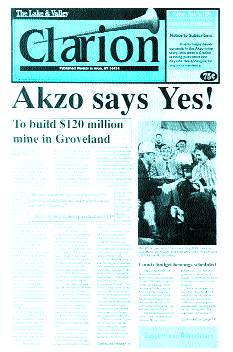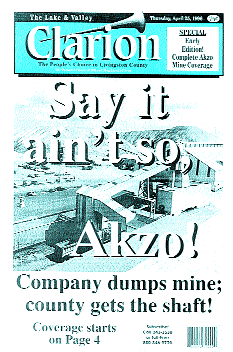
|
|
||
|
The
people's choice in Livingston County... and beyond!
|
||
A large typeface headline in the November 4, 1994 Clarion proclaimed, "Akzo
says Yes!" The company had agreed to spend $7.5 million in the first phase
of a project which would lead to construction of a new $120 million mine at
Hampton Corners. 
The plight of Harry Wadsworth was featured in the December 15 Clarion. He was not happy with the prospects of looking from his porch onto the what was going to be the heavy industrial activity of the new mine. Wadsworth (whose father Reverdy had sold the Hampton acreage to International Salt in1969) expressed the fears that were to be repeated by environmentalists as the new proposals gained momentum: that a new mine would lead to another ash proposal and another flooding event.
Flooding from the Retsof mine was even affecting the far away Hampton neighborhood. Wadsworth's neighbor and Geneseo Town Supervisor Harold Stewart had well damage, as reported on February 2, 1995.
"FANS drown[ed] out Akzo's critics" at a public meeting at Geneseo Central School reported in the January 19, 1995 Clarion. However, among the speakers was Peter Jemison, who expressed concern that "...my ancestors were laid in the ground there 200 years ago, and some maybe even longer. ...I don't want them dug up."
As corporate assistance programs were put in place, a planned tax abatement which would allow the G&W Railroad to weather the transition period while the new mine was under construction proved controversial. The agreement was subsequently modified so that G&W would have to pay back some of the abated taxes. The State of New York confirmed a $10.5 million assistance package for the G&W rail spur to the new mine.
On June 15, weary of all the lawsuits, animosity and debate accompanying the new mine proposal, Clarion Publisher Corrin Strong declared a moratorium on all mine-related news. "Neighbors and families have been divided against each other and many no longer seem to believe in the essential humanity of the other side," Strong wrote. The moratorium proved to be short-lived.
The first bit of post-moratorium mine news had slipped back into the newspaper by June 29. Ground subsidence had caused a temporary closing of the detour Route 20A routing around Cuylerville. The detour itself had been in effect since the collapse, when the Little Beards Creek bridge became impassable.
August 10 featured the fact that "More [South] Avon wells [were] running dry."
In September 1995 the Retsof mine closed after 111 years. Surface loading operations would continue until the large pile of salt, accumulated in the final 16 months of intensive mining, was sold and removed. In the following weeks 92 miners were layed off. Of the remaining 153 workers, 73 more would be laid off in October.
Also noteworthy was a report on farmer Myron Brady's fight to resist the construction of the G&W railspur through his farmland. The G&W would respond with a condemnation order.
Akzo had provided DEC with a 1,000 page environmental impact statement, accepted for consideration on September 22. Hearings were slated for November 1 and 2, in which about 1,000 people, including many white-capped FANS, would attend.
Mine opponents brought a steady barrage of charges before DEC Administrative Law Judge Kevin Casutto. An alphabet soup of interested groups and organizations presented briefs at the impact hearings: LCIDA, League of Woman Voters, Geneseo Town Planning Board, the miners' labor union, PACE, RAGE (Regional Action Group for the Environment), the Six Nation Iroquois Confederacy and Myron Brady.
Meanwhile the State Attorney General had gotten involved in assuring that Akzo
and its insurer would be compensating victims of well loss and subsidence damage.
The November 30 Clarion pictured Attorney General Dennis Vacco visiting the
damaged Route 20A bridge.
In a County Planning Board meeting reported December 7, Akzo gave assurances that the new salt mine would not have impacts on nearby buildings and wells. The new mine would confine its operations to the eastern flank of the Genesee Valley, where there was a thick bedrock support, experts said.
Although Judge Casutto had determined that certain further reviews of the Akzo permit ought to be done, in February 1996 DEC Commissioner Michael Zagata issued an executive decision to approve the Hampton mine permit. The permit was formally issued March 22.
In what would retrospectively proved to be the first sign of retraction of its commitment to the Hampton project, Akzo announced that it planned to retain old loading facilities at Retsof and scale back building size at Hampton.
On March 8 the court confirmed the G&W condemnation of the Brady land. But the unexpected 'story of the decade' was about to occur:
On April 25, Akzo startled the entire Livingston County community with the
announcement that it was pulling out of any commitment in building a mine at
Hampton Corners. No reasons were given. This time it was the miners and government
officials who felt betrayed. The Clarion proclaimed, "Say it ain't so,
Akzo!" with additional stories "County reels in shock-miners angry"
and "G&W Railroad future in doubt."
Forward to The Final Act?: American Rock Salt picks up the ball
According to
WebCounter you are the
person to answer the Clarion Call
©2000 Clarion Publications, Inc. All Rights Reserved.
This site designed by Clarion Communications.